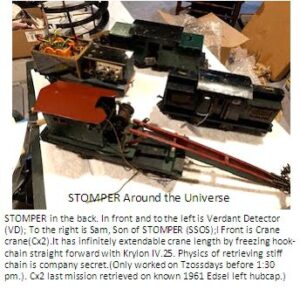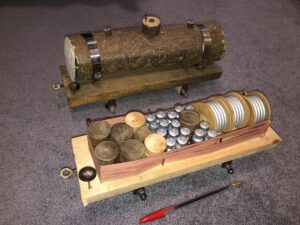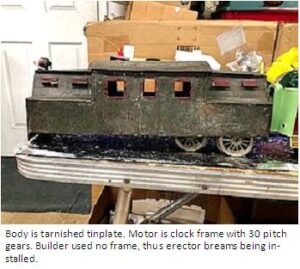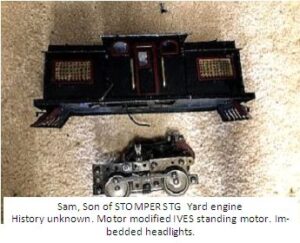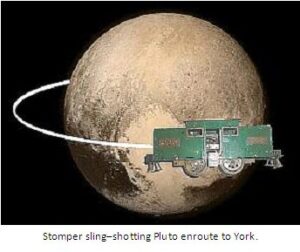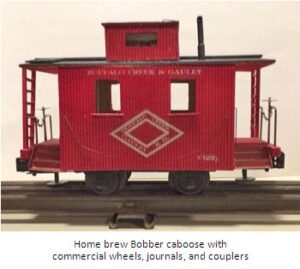HOMEMADE TRAINS AND ME! Part 1: The Beginning
Clem Clement, TCA Past President TCA# 64-987 Summer e*Train 2022
In my later years I have become fascinated with homemade trains, particularly standard gauge. They speak to me. I listen to their stories and feel their love. Crazy you say? Sure. Perhaps you see slopped paint, wrinkled tin, flaking cardboard and a mess. I see love; the love of someone who built the piece and the love of those who received it; the care of those who played with it; the ingenuity, creativity, and skill of the builder; the memories of those who held on to it through the years; and perhaps the sadness of letting go of those who have passed on.
Arno’s Blu Comet: One time, the late Arno Baars gave me a pile of Blue Comet obsy parts and asked “Could you have this assembled by noon (fav Q of mine. Most homey-dids we find have lost wheels and parts) Well, several years after Arno passed, I finally “got ‘er done.” We don’t have a history on this piece. It is a collection of passenger-car body slices from more than one donor. Some of the window inserts are O gauge. It clearly was assembled and then dissembled again. The sections added length to the car. Six- wheel trux carried the load. The interior sections had been repainted and the livery blanks were white, so the car is named Arno Baars #423. The base has 7 sections and 3 interior lights. 18 inches long not counting the couplers. The crown of the roof is in 3 sections; edges two. three mounting lugs. Two small bathroom doors per side at the front and one picture window per side in back connected to the Obsy platform for better viewing/being seen. Somebody worked hard on this beaut!
Back in the day I wanted more Standard gauge freights. I had a Lionel #8 an several 500 series. Passenger cars as well. As I have spoken on my writings, we lived in the next block from a Piggly-Wiggly grocery. Their trash area was in line-of-sight of my back fence. Every day on the way home I passed the piles of boxes and knew by label which were contained the best wooden sides and ends some were too flimsy or poorly constructed.
The Piggly Wiggly Super Market was my supplier. I would raid the trash pile behind the store and race home. Wash the squished grapes or fruit mush off the boards, dry them and remove the nails.
Many had one-inch wooden ends, which I harvested. The construction nails I liked were small 1.5 inch flat head tenpenny nails. I had a special nail puller that would snatch the nails out quickly. Then pop with a hammer on concrete to straighten them and into the nail can, they went. I still have a ½ jar. Slats for sides and thick ends for bases magically appeared. Straighten the soft nails and we are ready. Twine used woven between the nails makes a gondola; cut thread spools on dowels and you have flanged wheels. Or the common wooden cheese box when wheeled, was a strong standard gauge gondola.
Back in the day I wanted more Standard gauge freights. I had a Lionel #8 an several 500 series. Passenger cars as well. As I have spoken on my writings, we lived in the next block from a Piggly-Wiggly grocery. Their trash area was in line-of-sight of my back fence. Every day on the way home I passed the piles of boxes and knew by label which were contained the best wooden sides and ends some were too flimsy or poorly constructed.
The Piggly Wiggly Super Market was my supplier. I would raid the trash pile behind the store and race home. Wash the squished grapes or fruit mush off the boards, dry them and remove the nails.
Many had one-inch wooden ends, which I harvested. The construction nails I liked were small 1.5 inch flat head tenpenny nails. I had a special nail puller that would snatch the nails out quickly. Then pop with a hammer on concrete to straighten them and into the nail can, they went. I still have a ½ jar. Slats for sides and thick ends for bases magically appeared. Straighten the soft nails and we are ready. Twine used woven between the nails makes a gondola; cut thread spools on dowels and you have flanged wheels. Or the common wooden cheese box when wheeled, was a strong standard gauge gondola. (Lionel’s first gondola’s were modeled after cheese boxes. I use such today to hold small tools in my Model A Ford.) {Photo goes with this story}
I built 2 freights: A gondola and a tanker using the cut 1’ food-crate ends as bases. For the gondola, I lined up longer nails vertically close together along the edge of the base and used asparagus-wrapping cloth ribbon twine interlocked around the nails. For wheels, I cut wooden thread spools in half and used window curtain hangers for mounting the coat-hanger axles. It made a nice 4-wheel trucked gondola to carry other spools, marbles, pet frogs, etc.
The tanker was a learning situation for me. Same base and wheelsets. I chose a 3” diameter oak branch cut to length for the tank. Guess what: oak limbs don’t like 4” ten penny nails. Hand drilling was necessary, but slow and I bent a few rusty nails.
Somewhere, much later whey went away, so recently I duplicated the effort.
(Lionel’s first gondola’s were modeled after cheese boxes. I use such today to hold small tools in my Model A Ford.) {Photo goes with this story}
I built 2 freights: A gondola and a tanker using the cut 1’ food-crate ends as bases. For the gondola, I lined up longer nails vertically close together along the edge of the base and used asparagus-wrapping cloth ribbon twine interlocked around the nails. For wheels, I cut wooden thread spools in half and used window curtain hangers for mounting the coat-hanger axles. It made a nice 4-wheel trucked gondola to carry other spools, marbles, pet frogs, etc.
The tanker was a learning situation for me. Same base and wheelsets. I chose a 3” diameter oak branch cut to length for the tank. Guess what: oak limbs don’t like 4” ten penny nails. Hand drilling was necessary, but slow and I bent a few rusty nails.
Somewhere, much later whey went away, so recently I duplicated the effort.
I can think of many reasons for building a train piece. A set has a broken car with no way of replacing it. The cast body of a Lionel or IVES tender explodes due to age and an improper mix of metals. You need a replacement but you can’t part with what is left of original piece. Money is short, a suitable replacement can’t be found or you just want to build something unique to your life. Building just for fun is a powerful reason. Whatever your reason, the handyman and dreamer in you gets busy.
Arno’s Blu Comet: One time, the late Arno Baars gave me a pile of Blue Comet obsy parts and asked “Could you have this assembled by noon (fav Q of mine. Most homey-dids we find have lost wheels and parts) Well, several years after Arno passed, I finally “got ‘er done.” We don’t have a history on this piece. It is a collection of passenger-car body slices from more than one donor. Some of the window inserts are O gauge. It clearly was assembled and then dissembled again. The sections added length to the car. Six- wheel trux carried the load. The interior sections had been repainted and the livery blanks were white, so the car is named Arno Baars #423. The base has 7 sections and 3 interior lights. 18 inches long not counting the couplers. The crown of the roof is in 3 sections: edges two. three mounting lugs. Two small bathroom doors per side at the front and one picture window per side in back connected to the Obsy platform for better viewing/being seen. Somebody worked hard on this beaut!
A great quandary of mine, as I look at these wondrous pieces, is what came first: the junk parts that a visionary saw as a new gondola, engine or water tower or conversely, the train owner/builder in need of a certain car, who then chased after the parts? We may never know the true story but only have the joy of imagining the story to go with the train piece. A fellow I knows grandfather said one day “Grandson, do you want to go out to the barn and build a steam engine out of some junk I have?” He still has it and it runs fine. Part of my fun is figuring out where the parts came from that were used to construct these pieces. A tennis ball tube clearly can become a tank car. A soup or pineapple can is destined to morph into a water tower. But who would’a thunk that macaroni makes cool looking loco trim and fittings, pin heads make rivet heads, dowels make axles, and toy car tires make brake wheels? It gets tougher when they used Kiwi shoe‐shine can‐tops for water tower tops or pearl stick pins for headlight bulbs.
Wheels were a challenge for many creations, so in many cases old trucks from a busted train were selected to build/rebuild a found piece from the trash can. What did I use as a boy? For a base I used the end of an orange
crate. Remember those good pine ends? Remove the cheap nails and there you go. The Piggly Wiggly Super Market was my supplier. I would raid the trash pile behind the store and race home. Wash the squished grapes or orange mush off the boards, dry them and remove the nails. Ah hah! Slats for sides and thick ends for bases magically appeared. Straighten the soft nails and we are ready. Twine used woven between the nails makes a gondola; cut thread spools on dowels and you have flanged wheels or the common wooden cheese box when painted and wheeled, was a strong standard gauge gondola.
For me, even paint had to be found. I lived in Briganntine, NJ, during the war I would run the beach looking for cans and bottles of ½ empty paint that washed up on the shore. A quart jar washed in one day and I was thrilled. I had my trash‐can find of a Lionel ‘# 29‐day coach that needed repaint and that was the ticket. (The paint had been so shaken up by the ocean that although I saved the jar for 20 years, the paint never separated or hardened in the jar.)
When a homemade piece finds its way to me, I clean it and fix anything that was damaged from the way it was built. Loose and hanging trim gets fixed. (Ted Maurer believed do not fix/replace anything as it altered the originalness of the piece. One of the last pieces of guidance given to me by the late great Lou Redman was to try to keep members from upgrading trains by replacing/adding better parts as needed. That is “altering the piece and in his mind and the piece should be so marked. He was right!) Dents and wrinkles removed if the paint can stand the work. I try to remove rust, unless it adds to the provenance. I don’t repaint. The more patina the better! I use a lapidary tumbler on parts like the wheels which, if original, were usually plated. and many circumstances the wheels and trucks were from a toy train manufacturer and were removed by someone before I got it, for use on an original piece.
Whatever gauge, manufacturer, of type of train you collect remember it started in someone’s imagination and lived in their hearts. I hope our little ones are already hard at work building the trains of the future as they play and grow. Take time to share in their joy, encourage their dreams and help them to continue to make history so our future as hobbyists never fades.
EDITOR’S NOTE: Stay tuned for Part 2, coming in Fall, 2022

